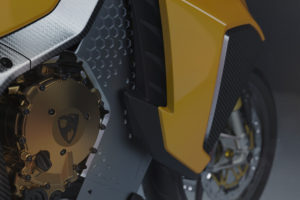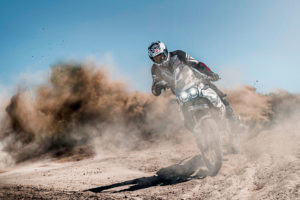Kawasakihas revealed the 2022 Ninja H2 SX SE, and it has a host of changes. According to Team Green:
For 2022, the Ninja H2® SX SE motorcycle returns to Kawasaki’s hypersport lineup, new and improved by blending performance and ultimate real-world handling with Kawasaki’s most advanced suite of rider assist technologies to date.
The Kawasaki Ninja H2 SX SE brings the latest in electronically controlled suspension, braking, and rider aid technologies to the supercharged hyperbike platform, making it the ultimate sport touring package.
This year’s changes are mostly of the technological variety. The H2 SX SE now comes with lots of electronic assistance and a few comfort and styling changes.
H2 SX SE Engine
So let’s get to it, shall we? It’s pretty well known that the bike’s supercharged 998 cc inline four-cylinder engine is a powerhouse. Some minor changes to the powerplant have been made, including revised cam timing and elimination of the exhaust’s pre-silencer chamber. There are also changes to the bike’s exhaust that permit “greater freedom with the new exhaust layout that features a longer collector pipe, increased catalyzer volume, and a larger silencer. In addition, the new straight-pipe style layout delivers improved torque to benefit everyday rideability.”
The bike’s engine performance is increased. Unfortunately, Kawasaki doesn’t provide precise figures about the effect these changes have on the bike’s horsepower, torque, or overall performance. Nonethless, horsepower and torque both increase.

This chart shows that both HP and torque increase. However, the values are not quantified.
The bike’s clutch has also been massaged, including a revision to the volume of hydraulic fluid routed to the clutch plates. The change reportedly offers a noticeable improvement when stopped and makes shifting into neutral easier.
H2 SX SE Technology updates
And that’s about it for the bike’s mechanical changes. It’s the technology stuff that makes this update significant.
Advanced Rider Assist System (ARAS)
This year’s bike comes with Bosch’s Advanced Rider Assist System (ARAS). It has surround-sensing functions using sensors to generate a “more relaxed riding experience.” The more relaxed experience is the result of the installation of adaptive cruise control (ACC). It automatically maintains the speed set by the rider but adjusts the motorcycle’s speed to maintain a “suitable” following distance from the vehicle in front.

The configuration of Kawasaki’s ARAS system.
As for how the system operates, Kawasaki says:
When the system is operating, a signal is shown on the instrument panel, including the symbol showing green when following a vehicle ahead and grey when there is no vehicle ahead. Once operational speed gets to a certain point, which varies in each gear, the system will disengage, and the rider will need to operate the brakes manually.
Pressing the cruise control button on the left side of the handlebar turns the system off. Operating the brakes or engaging the clutch for several seconds causes ACC to be temporarily disengaged and closing the throttle completely will also disengage the system. Accelerating (throttle override) or shifting gears (as long as the new gear’s minimum operation speed is met) does not disengage the system unless the maximum speed allowed is reached.
Forward Collision Warning (FCW)
The bike also has Bosch’s Forward Collision Warning (FCW) system. It was designed to reduce the risk of a motorcycle “rear-ending” a vehicle in front or mitigate such a collision’s consequences using front-facing sensors.
The system automatically arms itself when the motorcycle starts and provides assistance in “all relevant speed ranges.” If FCW detects another vehicle is too close, and the rider does not react, it warns the rider with a bright flashing red LED above the instrument panel, while a warning is also shown on the bike’s TFT display.
Riders can set the system’s alert timing to their preference, including early, medium, or late. FCW can also be turned off, and that fact will be indicated on the display.
Kawasaki Electronic Control Suspension (KECS) with Showa Skyhook EERA technology
The 2022 H2 SX SE features Kawasaki Electronic Control Suspension (KECS). It helps support the bike’s sprung weight and modulates the suspension’s damping force. While the motorcycle is in operation, the KECS system helps the “wheels to track road dips and bumps while maintaining the motorcycle’s vertical position with minimal disturbance.” Kawasaki says that KECS provides both suppleness for riding comfort in a wide range of riding situations, as well as firm damping to facilitate sport riding.
As for the suspension components, the H2 SX SE sports a 43 mm inverted Showa cartridge fork and a “high-spec” Showa Balance Free Rear Cushion (BFRC) lite rear shock. It is similar to the shock found on the Ninja ZX-10R sportbike. However, this unit also features an electronically adjustable preload.

Kawasaki’s KECS suspension components.
Suspension details
As for the details on the suspension system, Kawasaki says:
In the BFRC lite shock, damping force is generated in an external Damping Force Chamber, and compression and rebound damping are generated independently, allowing the whole surface of the main piston to act as a pump, pushing oil towards the valves. This configuration also helps to suppress pressure balance fluctuations as a result of shock compression and extension.
Compression and rebound damping for both the forks and shock are generated (and adjusted) electronically via the KECS system that is controlled by a solenoid valve with direct actuation and allows for extremely quick reaction time. Riders can choose from four modes: Sport, Road, Rain, and Manual. KECS then adjusts to the road surface environment in real time to provide the ideal damping, considering vehicle speed, stroke speed and deceleration. Riders can electronically control the rear shock preload settings as well. KECS offers three different preload settings: rider only, rider with luggage, and rider with passenger and luggage. Riders can fine-tune these settings with 10 levels of adjustment for each.
The updated software incorporates Showa’s Skyhook EERA (Electronically Equipped Ride Adjustment) technology to deliver an even more composed ride. Showa’s Skyhook software, carefully fine-tuned by Kawasaki engineers to ensure the sporty riding character of the Ninja H2 SX SE was preserved, delivers a smoother ride as it continually adapts to the road surface in real time.
叉子和冲击传感器内置的中风that provide real-time stroke speed and compression information. The sensor coils provide input to the KECS ECU every millisecond. This is complemented by information provided by the IMU (acceleration/deceleration) every 10 milliseconds and the FI ECU (vehicle speed) every 10 milliseconds. The KECS ECU then directs current to the solenoids to adjust damping as required by the situation.
Blind Spot Detection (BSD)
The Blind Spot Detection (BSD) system senses in all directions to assist riders with lane changes. A rear-facing radar sensor acts as the BSD system’s eye. It can observe objects in hard-to-see areas on both the left and right sides of the motorcycle.
When the system detects an approaching vehicle, an LED built into the rearview mirrors will illuminate. Also, if the rider activates a turn signal while a vehicle is in the blind spot, the mirror LED will flash to alert the rider.
If a rider turns off the BSD, the bike’s display will indicate that the system is off.

The left side of the 2022 Kawasaki H2 SX SE.
NewBosch 10.3ME ABS IMU
新H2 SX SE川崎的第一个模型强度grate a new FI-ECU with torque demand. It measures six degrees of freedom (DOF). The new IMU can measure acceleration along longitudinal, transverse and vertical axes, plus roll rate, pitch rate, and yaw rate. Think of the system as the “black box” that controls the autopilot of an aircraft.
Data from the IMU provides a real-time picture of the bike’s chassis orientation. In addition, with its sophisticated torque demand capabilities, the new FI-ECU can adjust torque in response to external direction and work in concert with the bike’s ABS.

A skeleton view of the H2 SX SE.
Vehicle Hold Assist (VHA)
The Vehicle Hold Assist (VHA) activates when a rider stops and firmly applies the brakes. VHA will then engage the rear brake, and the TFT display will alert the rider that they can relax their grip on the hand brake. Once the rider turns the throttle, the sidestand goes down, or 10-minutes after activation, the VHA disengages automatically.
Kawasaki Intelligent Proximity Activation Start System (KIPASS)
新今年H2 SX implementatio SEn of Kawasaki’s KIPASS starting system. It’s a master key system that acts as a deterrent to theft and vandalism. Using a compact key that can stay in your pocket, KIPASS sends out a signal to be the ECU. Once recognized, the key allows remote activation of the ignition switch and the bike’s steering lock.

Kawasaki’s KIPASS key and a manual key.
Tire Pressure Monitoring System (TPMS)
Tire pressure monitoring systems aren’t new. But one now comes standard on the Ninja H2 SX SE. Kawasaki’s version of the system continuously monitors tire pressure while riding. For example, if a tire’s pressure falls below 31.9 PSI, the bike’s TFT display will show a low-pressure warning.

This year’s machine includes TPMS.
SPIN app
The bike’s 6.5-inch full-color TFT “instrumentation screen now offers smartphone connectivity as well as compatibility with Kawasaki’s “SPIN” smartphone-based infotainment app. Basic functions available in the app include telephone, map display, music, calendar, and contacts.
The SPIN app also allows riders to download and add third-party apps to their SPIN library and have the apps operate on the bike’s TFT display. Kawasaki says available apps include Sygic (navigation), SENA (headset communication), and more.
The SPIN system will also provide riders with access to several functions, including:
Vehicle Info:information such as fuel gauge, odometer, maintenance schedule, which can all be viewed via the smartphone
Riding Log:GPS route information as well as vehicle running information can be logged and viewed via the smartphone
Telephone Notices:when a call or mail is received by the smartphone, this is indicated on the instrument display
Styling
There are changes to the bike’s upper and side cowl, a new LED headlight, and more aerodynamic mirrors. A new upper cowl features angular lines and a slim, compact look. It maintains its styling even with the radar sensor positioned below the headlight. It sits behind a cover, specially designed to not interfere with the radar function.
- The H2 SX SE’s sensors are nicely hidden
Ergonomics
To make riding a more comfortable affair, there are changes to the bike’s ergos. For 2022, the H2 SX SE comes with wider seats, a new USB-style power outlet, heated grips, and a new Brembo front master cylinder.
Pricing
The 2022 Ninja H2 SX SE carries an MSRP of $27,500. The sole color scheme is Emerald Blazed Green/Metallic Diablo Black/Metallic Graphite Gray.
All photo credit: Kawasaki









